It was an exhibition that remains legendary—21 of the world’s 36 known Vermeer paintings, a government shutdown, a blizzard, and hordes of fanatics desperate to see the “Mona Lisa of the ’90s” (as The Girl With the Pearl Earring became known).
On Sunday, Oct. 22, the National Gallery of Art in Washington, D.C., will attempt to recreate that Super Bowl of art exhibitions from 1995 with a new one titled Vermeer and the Masters of Genre Painting: Inspiration and Rivalry. If the crowds in Paris and Dublin over the past year at the show’s two other stops are any indication (or the endless number of calls, letters, and emails the museum has received from “Vermeerists”), the Gallery will find itself with another runaway success. It will also give the city of Washington its second blockbuster art show this year (the first being Yayoi Kusama at the Hirschhorn) that skipped New York’s puffed-up art scene to the north.
The crowds will be a well-deserved feather in the cap of the museum and its longtime curator of northern baroque paintings, Arthur K. Wheelock. It not only has a crowd-pleasing 10 Vermeer’s in the exhibition (two of the museum’s four Vermeer’s are in it), but the whole showcase is actually a magnificent feat of legerdemain on the part of the curators: Using Vermeer to introduce the casual art enthusiast to the more obscure progenitor of Dutch high-life genre painting—Gerard ter Borch.
ADVERTISEMENT
“We really should have called it ‘Ter Borch and the Masters of Genre Painting.’ It is ter Borch, ter Borch, ter Borch,” confides Wheelock, in an interview with The Daily Beast. “Ter Borch is key to the whole thing. The stories that unfold in this show and the new attitudes towards genre are courtesy of ter Borch.”
It was ter Borch, according to the curators, who transformed genre painting in the 1650s by inviting the viewer into private domestic moments, particularly of young, often wealthy, women. Women writing letters, washing their hands, practicing an instrument, gazing into the mirror or out the window—ter Borch transformed the quotidian into the extraordinary. His half-sister Gesina, who was also a poet, was often his model, and the centerpiece of his innovations. It is Gesina who appears in his 1652 Woman at a Mirror, which began to use the mirror as a way of adding another layer of voyeurism to these private scenes, and reappears as he continues to develop it in the 1660 Lady at Her Toilet.
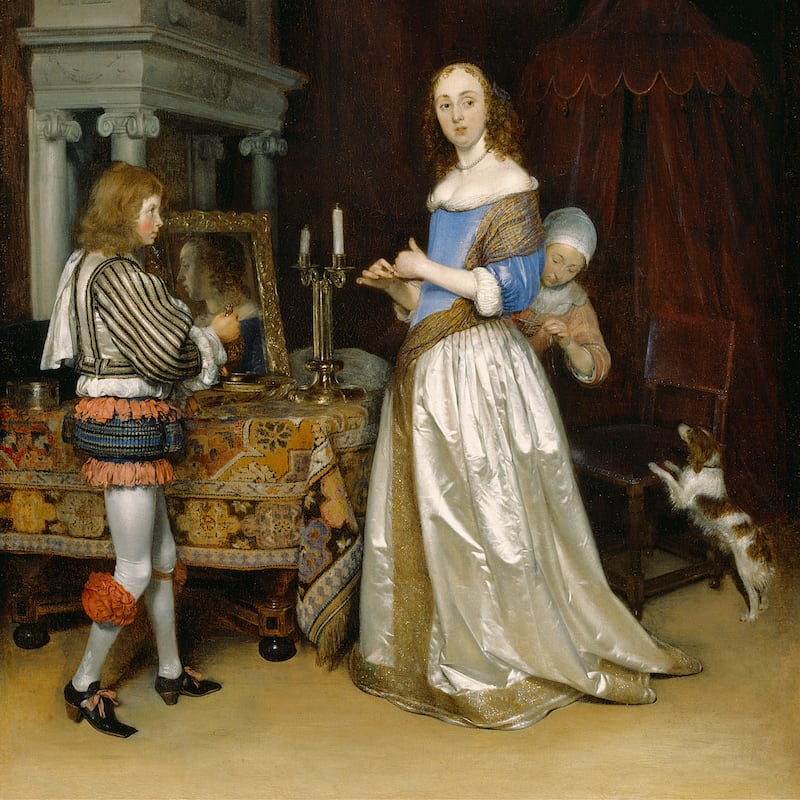
Gerard ter Borch "Lady at Her Toilet" c. 1660
The Detroit Institute of Arts“In moments like this, the mirror lets you see moments that were not meant for any person to see—this develops into this whole play off uncertainty,” explains Wheelock, who displays an unbridled enthusiasm, as he bounces around from 400-year-old painting to 400-year-old painting, that belies his 74 years. (Forty-two of those have been as curator at the Gallery.) Ter Borch, he explains, creates curiosity as to who Gesina is looking at as she twists the ring on her finger.
Around the same time, ter Borch was also introducing what the curators dub one of his “most lasting innovations” of the standing woman facing away from the viewer. The 1654 Gallant Conversation leaves the viewer simultaneously intrigued by stumbling upon a private conversation and yet stymied because the exact nature of the discussion—as well as the woman’s reaction—remain a mystery. The piece was so influential that Samuel van Hoogstraten would include a variation of it as a painting on the wall of his View of an Interior. Painting the woman facing away from the viewer also gave these masters of detail another opportunity to highlight one of their more lucrative skills—immaculate depiction of luxury clothing.
But if the exhibition demonstrates the integral role played by ter Borch, it also delivers on making clear that Vermeer took those innovations and elevated Dutch genre painting to a point where its appeal has become timeless.
“It’s the ongoing question,” grimaces Wheelock, when asked, for what must be the thousandth time, why Vermeer has remained king. He promptly wanders into the room containing Vermeer’s Woman with the Pearl Necklace.
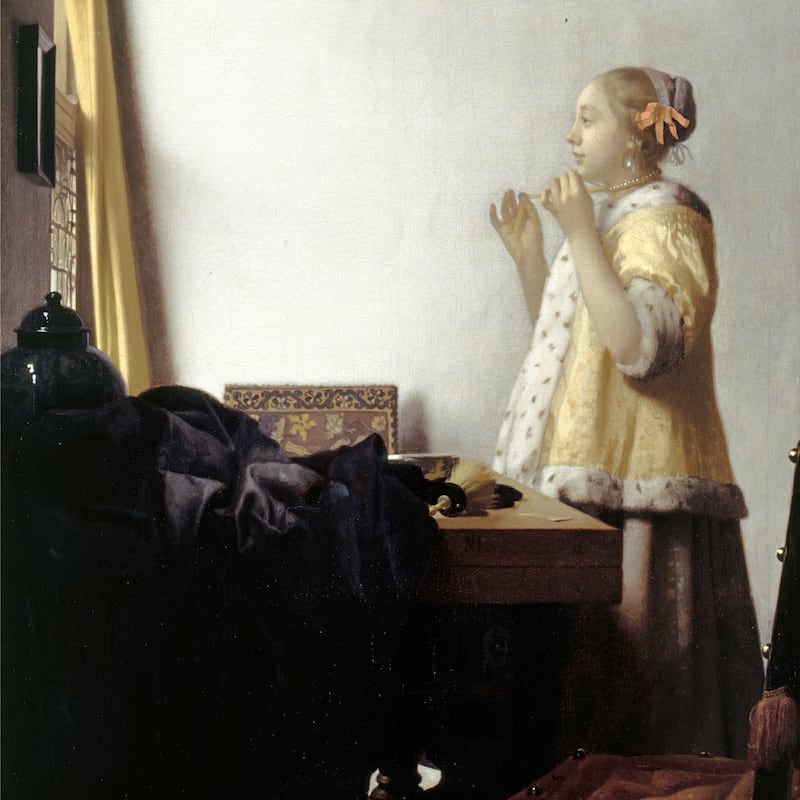
Johannes Vermeer "Woman with a Pearl Necklace" c. 1662-65
Staatliche Museen zu Berlin“She’s standing there, poised, looking across the empty expanse with that wonderful wall and mirror behind her in a way that looks like she would never move, transfixed in time,” he explains. “That is true also of The Woman Writing a Letter. In that sense of permanence one gets an element of dignity in doing things that are pretty much daily activities. Vermeer finds these moments and makes them important, and hence we feel more important in our connections with them. You come away from Vermeer feeling better about yourself after you saw it.”
Then, walking by works by Steen, Metsu, Dou, and ter Borch, Wheelock frankly admits, “I don’t think that’s the case with the other paintings. They have interesting elements. It’s interesting to see the way people interact and experience each other. But unlike Vermeer, what you have with these paintings is they are specific to a time and place, they are very specific to Dutch 17th century.”
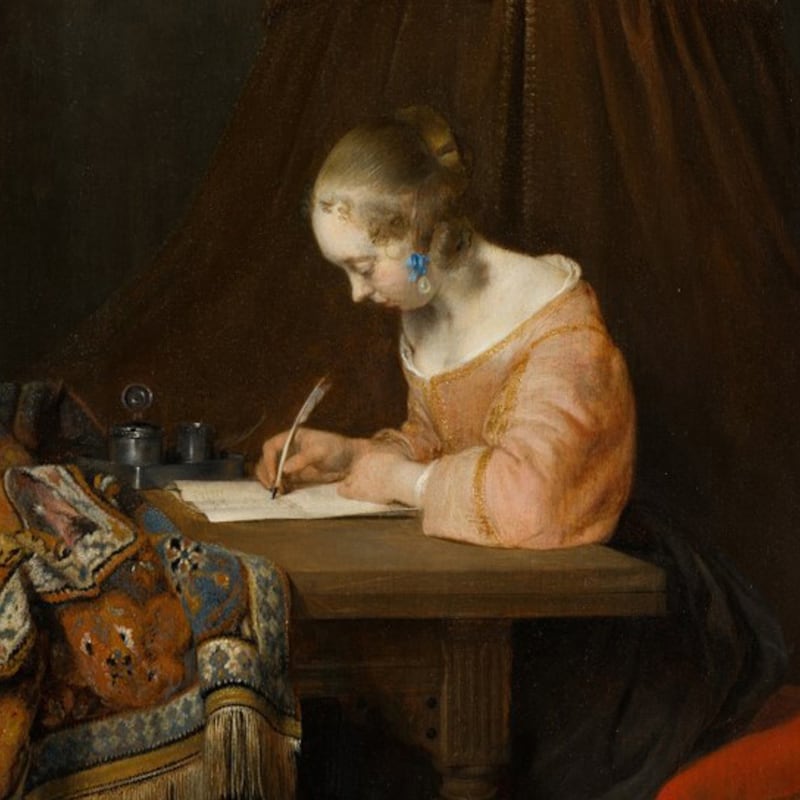
Gerard ter Borch "Woman Writing a Letter" c. 1655-56
Royal Picture Gallery Mauritshuis, The HagueIn an exhibition where paintings by “The Sphinx of Delft” are hung next to works of the exact same scene (woman writing a letter, balancing the scales, playing an instrument) by his contemporaries, what becomes remarkably apparent, and what makes this exhibition so memorable, is what separates Vermeer from the pack.
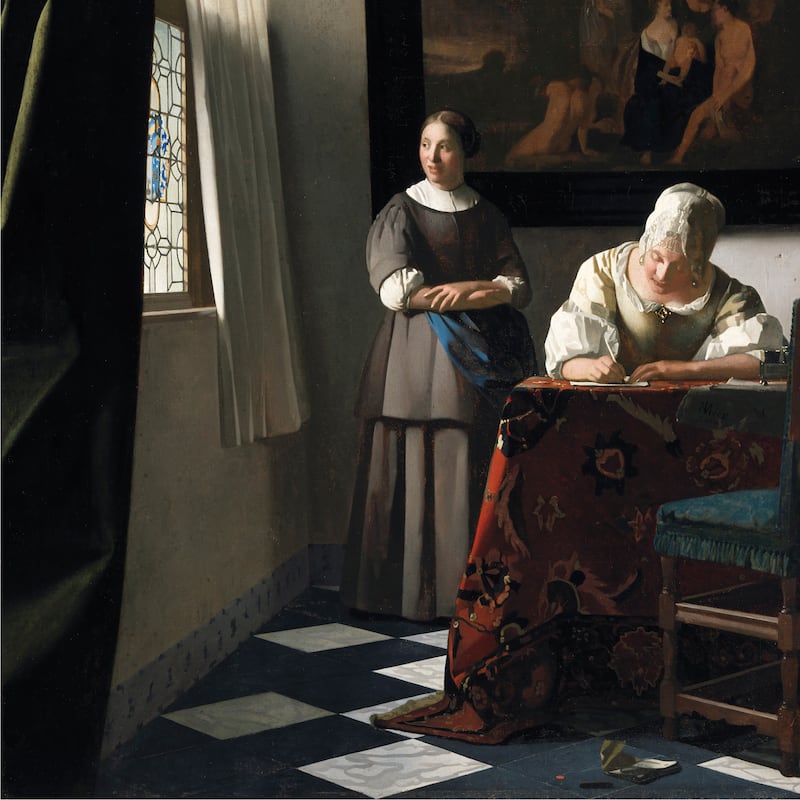
Johannes Vermeer "Woman Writing a Letter, with her Maid" c. 1670-71
National Gallery of Ireland“Vermeer often eliminates elements,” Wheelock points out. “So that an environment that is so associated with the 17th century becomes less and less 17th-century and can be connected to the world we live in.” Think of the blank walls or the way furniture become more geometric elements than having to do with narrative or time and place. “They’re not Dutch 17th-century paintings any more, they speak to us because they’ve become universal,” he surmises. “Once you see a Vermeer, you never forget it. You don’t forget where you saw, when you saw it, and it becomes a part of you.
Of course it doesn’t hurt that the psychology of scarcity is also involved, as there are only 36 known paintings by Vermeer.
All of that isn’t to say that Vermeer or ter Borch dominate the show. For any person with a functioning eyeball, the most mesmerizing work in the show is Gabriel Metsu’s Man Writing a Letter.
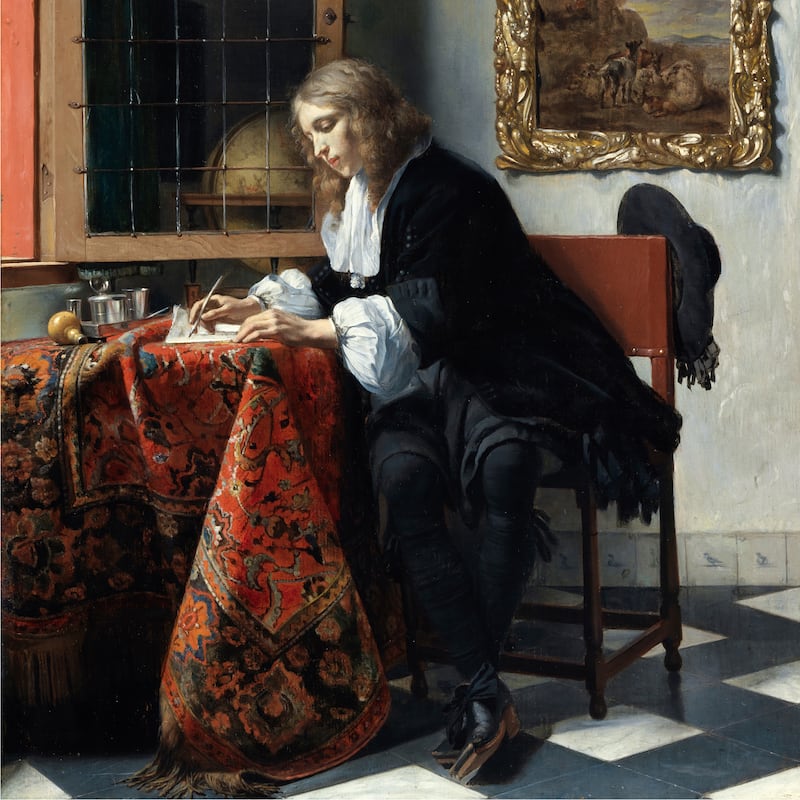
Gabriel Metsu "Man Writing a Letter" c. 1664-66
National Gallery of IrelandAs anybody who has spent any time with Dutch genre masterworks knows, careful contemplation pays off. In fact many of these paintings, including some of those by Vermeer, were originally hung with doors covering them.
One such painting is Gerrit Dou’s A Young Woman at Her Toilet, which hangs next to the ter Borch mirror paintings. In A Young Woman at Her Toilet, the viewer would have opened the painting doors to find the woman staring right at them in the mirror.
“She’s looking at you and it’s sort of come-hither in a way,” Wheelock contends. “And because it was in a box, when you opened the doors she was looking at you and it was very personal. She’s looking directly at you so there’s a whole connection, so it was very different than walking in a gallery”
That same painting is also a prime example of how, with Dou, as Wheelock says, “you’ve got to get up close to see the amazing detail. He forces you to get close, he puts you at a certain perspective point, distance point.” That’s why the marble basin in the foreground of the painting seems out of proportion. You need to get up close and, well, personal. Dou is believed to be the first living subject of a monographic show when, in 1665, 27 of his paintings were shown in Leiden (22 in boxes).
If you engage is that careful contemplation, the monotony of paintings about women’s purity and proper behavior might just be broken up with the realization that—yes, in fact—there are two dogs getting it on in the middle of one of the paintings.





